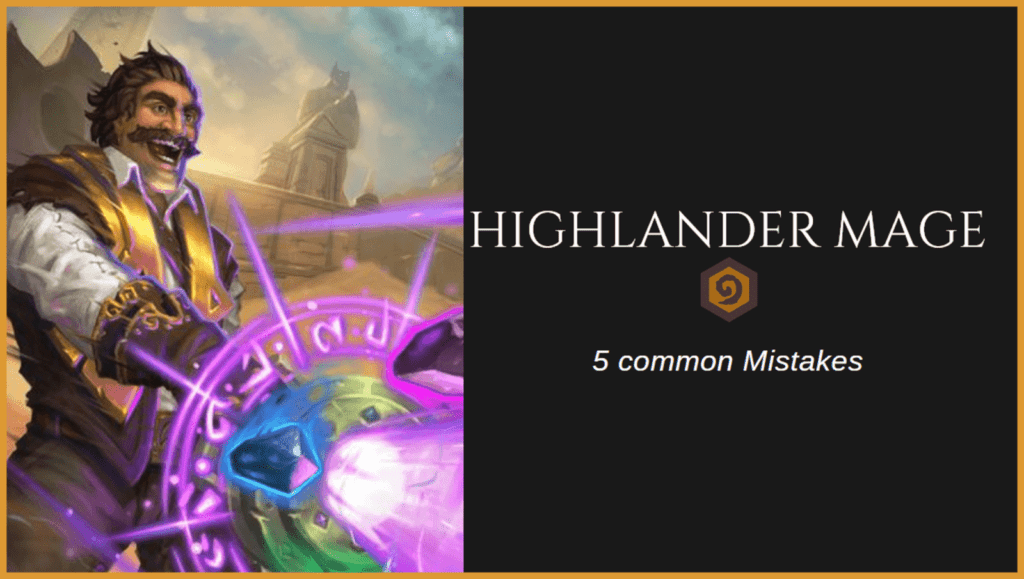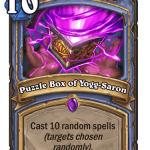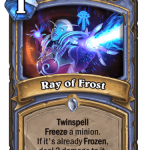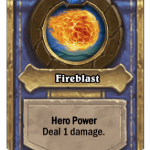- March 17, 2020
- By neon31
- In Articles, Guest Post
- No Comment
- 0
Highlander Mage – 5 common Mistakes

Table of Contents
About the author
Hello there, I’m BrianOBryan and have been playing Hearthstone since late 2014. I’ve reached Legend multiple times in both Standard and Wild with a couple top 200 finishes
Mage is my favorite class and I figured to use it as the topic of discussion for my first Hearthstone write-up!
So for this one I wanted to get started with something not as lengthy as a full on guide, but still informative enough to help others improve their Mage game play.
I have over 2,000 Mage wins in constructed and finished #118 in February with a peak of Top 69 Legend.
Top 69 NA with Reno Mage. Same list. pic.twitter.com/bJo4Az3tlD
— BrianOBryan (@BrianMayeshiro) February 18, 2020
» Social Media
Twitter: https://twitter.com/BrianMayeshiro
Highlander Mage - Stocklists
Common Mistakes
It’s not possible to cover every single mistake so DO NOT assume all the points mentioned in this write-up are the only ones people make. These are just 5 of the common mistakes I noticed players making with Reno Mage. Note that this write-up is targeted towards inexperienced or newer players. People who are well versed in piloting the deck may not gain as much insight.
» 1. Not Playing Zephrys for Wild Growth on Curve
By far this is the most common mistake I’ve noticed inexperienced players make with Reno Mage. Zephrys (Zeph) is often kept as a reactive card in the start too often. Even though Reno Mage is a control deck and it seems better to save Zeph for a board clear/removal, not playing Zeph on turn 2 for Wild Growth is a HUGE mistake. With the exception of aggro decks like Dragon Hunter where it might be better to use Zeph for a backstab/sac pact/ooze, it’s way more advantageous to use it for Wild Growth.
Wild Growth is an immensely helpful tool for Reno Mage as the deck has a slow start and makes its powerful turns around turn 6 with Reno the Relicologist or Dragoncaster + Big Spell. Ramping faster to your powerful turns is a huge benefit and especially on coin where you can wild growth into a coin + Reno turn. If you are offered Zeph in your starting hand and have the option to play it on curve and are not against hunter, 99% of the time you play it and pick Wild Growth.
» 1. Not Playing Zephrys for Wild Growth on Curve
By far this is the most common mistake I’ve noticed inexperienced players make with Reno Mage. Zephrys (Zeph) is often kept as a reactive card in the start too often. Even though Reno Mage is a control deck and it seems better to save Zeph for a board clear/removal, not playing Zeph on turn 2 for Wild Growth is a HUGE mistake. With the exception of aggro decks like Dragon Hunter where it might be better to use Zeph for a backstab/sac pact/ooze, it’s way more advantageous to use it for Wild Growth.
Wild Growth is an immensely helpful tool for Reno Mage as the deck has a slow start and makes its powerful turns around turn 6 with Reno the Relicologist or Dragoncaster + Big Spell. Ramping faster to your powerful turns is a huge benefit and especially on coin where you can wild growth into a coin + Reno turn. If you are offered Zeph in your starting hand and have the option to play it on curve and are not against hunter, 99% of the time you play it and pick Wild Growth.
» 2. Not keeping Pocket Galaxy in the Mulligan
The mulligan is one of the most important aspects of the deck as it includes a lot of powerful cards that can swing the game. We have Zeph, Reno the Relicologist, and Pocket Galaxy as key cards to have in your starting hand. Oftentimes I notice players throwing away Pocket if it’s offered in the mulligan. This is a common mistake as Pocket is one of the best cards in our deck despite its mana cost.
Aside from more aggressive decks like Galakrond Warrior and Hunter, Pocket is insanely powerful against slower decks. With cards like Zeph and Dragoncaster, it’s possible to get Pocket off earlier than turn 7. Sometimes you can get lucky and curve with Zeph + Wild Growth into a coin + Dragoncaster + Pocket. Even though it seems like a downside to waste an entire turn playing Pocket, the resulting payoff compensates for that. Since a lot of minions in our deck are of high mana cost, being able to get our more expensive minions (e.g. Dragonqueen, Kalegos) at 1 mana makes up for the downside of your Pocket turn most of the time. The post-pocket follow up is a massive swing turn and is even more powerful when combined with card draw like Stargazer Luna/Arcane Intellect/Book of Specters.
» 2. Not keeping Pocket Galaxy in the Mulligan
The mulligan is one of the most important aspects of the deck as it includes a lot of powerful cards that can swing the game. We have Zeph, Reno the Relicologist, and Pocket Galaxy as key cards to have in your starting hand. Oftentimes I notice players throwing away Pocket if it’s offered in the mulligan. This is a common mistake as Pocket is one of the best cards in our deck despite its mana cost.
Aside from more aggressive decks like Galakrond Warrior and Hunter, Pocket is insanely powerful against slower decks. With cards like Zeph and Dragoncaster, it’s possible to get Pocket off earlier than turn 7. Sometimes you can get lucky and curve with Zeph + Wild Growth into a coin + Dragoncaster + Pocket. Even though it seems like a downside to waste an entire turn playing Pocket, the resulting payoff compensates for that. Since a lot of minions in our deck are of high mana cost, being able to get our more expensive minions (e.g. Dragonqueen, Kalegos) at 1 mana makes up for the downside of your Pocket turn most of the time. The post-pocket follow up is a massive swing turn and is even more powerful when combined with card draw like Stargazer Luna/Arcane Intellect/Book of Specters.
» 3. Yogg Box Timing
This one seems ridiculous to identify as a mistake, but there’s actually a correct and incorrect time to play Puzzle Box of Yogg Saron. Ideally the best times to play Box is early (through Dragoncaster), when you don’t have many cards in hand or the board is not full of minions. In most cases, Box will give you cards and maybe provide some tempo on the board through cards that pull or generate minions.
Using Box on a board with healthy minions is usually used more for a last resort as the chances of getting a clear or freeze is unlikely. There’s always a chance Box can pull a miracle to help in those situations and it’s the only option, but Box is more likely to provide value or buff minions on the board. The best times to Box is when the board has only a few minions and when you don’t have many cards in hand as it is likely to overdraw you.
» 3. Yogg Box Timing
This one seems ridiculous to identify as a mistake, but there’s actually a correct and incorrect time to play Puzzle Box of Yogg Saron. Ideally the best times to play Box is early (through Dragoncaster), when you don’t have many cards in hand or the board is not full of minions. In most cases, Box will give you cards and maybe provide some tempo on the board through cards that pull or generate minions.
Using Box on a board with healthy minions is usually used more for a last resort as the chances of getting a clear or freeze is unlikely. There’s always a chance Box can pull a miracle to help in those situations and it’s the only option, but Box is more likely to provide value or buff minions on the board. The best times to Box is when the board has only a few minions and when you don’t have many cards in hand as it is likely to overdraw you.
» 4. Wasting Freezes
Freeze is an important, but difficult tool to use correctly when piloting Reno Mage. A common mistake I notice from players is that they are not valuing their freeze effects enough and using them on a minion or a board with low attack. For example, a card like Ray of Frost is commonly used as a 1 mana freeze effect to stall damage from a minion for at least a turn. That way you save yourself a lot of damage and stall until you can either clear with something like Reno/Siamat or to contest the board by dropping minions of your own.
When using Freezes, it’s intended for either stalling or setting up a board that your opponent can’t deal with since their minions are frozen. I’ve won many games simply through developing a board of minions and using a card like Frost Nova/Blizzard to lock out the opponent’s board and have a lethal setup the following turn. Being a singleton deck, we’re pretty limited in the amount of Freezes we have available so you have to use them wisely. Otherwise you end up putting yourself in situations where you are forced to discover a freeze to prevent dying which is not an ideal situation to be in.
» 4. Wasting Freezes
Freeze is an important, but difficult tool to use correctly when piloting Reno Mage. A common mistake I notice from players is that they are not valuing their freeze effects enough and using them on a minion or a board with low attack. For example, a card like Ray of Frost is commonly used as a 1 mana freeze effect to stall damage from a minion for at least a turn. That way you save yourself a lot of damage and stall until you can either clear with something like Reno/Siamat or to contest the board by dropping minions of your own.
When using Freezes, it’s intended for either stalling or setting up a board that your opponent can’t deal with since their minions are frozen. I’ve won many games simply through developing a board of minions and using a card like Frost Nova/Blizzard to lock out the opponent’s board and have a lethal setup the following turn. Being a singleton deck, we’re pretty limited in the amount of Freezes we have available so you have to use them wisely. Otherwise you end up putting yourself in situations where you are forced to discover a freeze to prevent dying which is not an ideal situation to be in.
» 5. Pinging Galakrond Warrior or Quest Priest on 2
Lastly we have a more fringe mistake, but one that could potentially affect the outcome of the game. With most decks it makes sense to be mana efficient and use your hero power if there’s no other play. However, if we’re playing Reno Mage against Gala Warrior or Quest Priest that changes. In the case of Priest, it makes no sense to ping their face on 2 as it accomplishes nothing aside from advancing their quest by 1. Quest Priest usually doesn’t have a turn 2 play aside from hero power anyway.
When facing up against Gala Warrior, it’s better to not ping your opponent’s face with the hero power on turn 2 as you immediately damage them in range for an extra card from Battle Rage. Since most lists run armorsmith now, I find that sometimes my opponent starts to gain too much armor and will never be able to get that extra card from having the hero damaged. Against a deck like Gala Warrior, we are less concerned about racing them in the beginning. We care more about being able to deal with their board and place well timed taunts against all their invoke damage and charge minions.
» 5. Pinging Galakrond Warrior or Quest Priest on 2
Lastly we have a more fringe mistake, but one that could potentially affect the outcome of the game. With most decks it makes sense to be mana efficient and use your hero power if there’s no other play. However, if we’re playing Reno Mage against Gala Warrior or Quest Priest that changes. In the case of Priest, it makes no sense to ping their face on 2 as it accomplishes nothing aside from advancing their quest by 1. Quest Priest usually doesn’t have a turn 2 play aside from hero power anyway.
When facing up against Gala Warrior, it’s better to not ping your opponent’s face with the hero power on turn 2 as you immediately damage them in range for an extra card from Battle Rage. Since most lists run armorsmith now, I find that sometimes my opponent starts to gain too much armor and will never be able to get that extra card from having the hero damaged. Against a deck like Gala Warrior, we are less concerned about racing them in the beginning. We care more about being able to deal with their board and place well timed taunts against all their invoke damage and charge minions.
Conclusion
Thanks for reading my first ever article for Hearthstone! Hope I was able to provide insight about Reno Mage and how to avoid those common mistakes. Once again this write-up is meant for players inexperienced or new to the deck. For more insight on the advanced intricacies of Reno Mage, I’d recommend watching my stream or vods. I try to explain my thought process to the best of my ability.
If you want to see more of me here is my latest Stream:
Reno Mage Coaching Co-op with GuyGrumpy
More Highlander Mage Decks
We just featured two version of Highlander Mage, but there are a lot more ways to build. For this reason, we feature the newest lists we posted on this website below.
You might also be interested in...
- Phone vs Tablet: Which Should You Use for Gambling in Online Casinos? November 24, 2025
Submit your Top 500 Legend Build, be seen by thousands of people!







